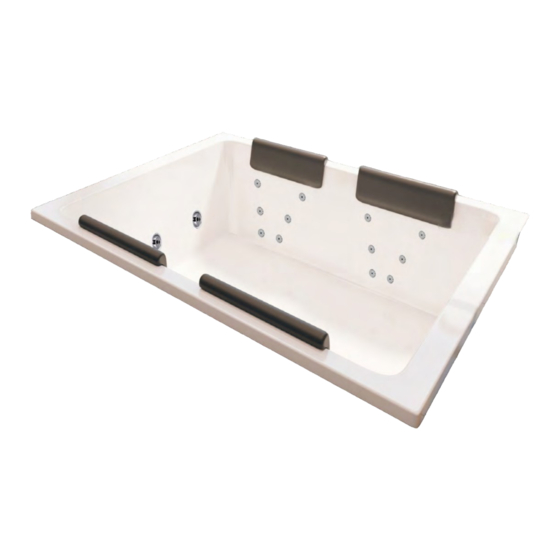- ページ 3
ホットタブ decina SANTAIのPDF インストレーション&オーナーズマニュアルをオンラインで閲覧またはダウンロードできます。decina SANTAI 8 ページ。

BATH INSTALLATION
All acrylic baths need to be supported under all rims as well as
supporting the full length of the bath.
NOTE DO NOT USE FOAM TO SUPPORT THE BASE OF
!
ANY BATH.
SUPPORTING THE BASE - THERE ARE 3 TYPES OF BASE SUPPORT
1
BATHS WITH SELF SUPPORTING FEET
∙
Some baths (only those with 5 PVC circles glassed to the base) can be installed on a firm level surface without the need to
use a mortar bed. Use a cement based adhesive to glue the base pads to the floor. This must only be done where the support
area is completely smooth, clean and level. Spread adhesive liberally over the support floor and base pads and allow for
adequate time for it to cure. On a timber floor it is necessary to first lay a fibre cement sheet in accordance with the
manufacturer's installation instructions. The bath feet must then be adhered to the sheet with a concrete based adhesive.
MORTAR BASE
∙
Allow a minimum of 50mm for the mortar bed. Mix the
mortar to a dryish consistency to minimise shrinkage and
droop. Include a bonding Agent such as BONDCRETE in the
mix. It is a requirement of the water authorities that all
non-self-supporting baths be supported the full length of the
bath base on a mortar mix. When installing an Island bath,
the full perimeter also has to be supported by a 'frame' of
timber or masonry as per DIAGRAM D.
BATHS WITH A BASE SUPPORT FRAME
∙
When baths are supplied with steel base (and/or base and rim)
support frame, the bath should be slipped into position and
the top levelled by adjusting the feet on the frames. All of the
adjustable feet of the frame must be in full contact with the
floor, so that the base is fully supported.
A MORTAR MIX MUST ALSO BE LAID TO FILL THE VOID BETWEEN THE BOTTOM OF THE BATH & THE FLOOR WITHIN
!
THE FRAME PERIMETER IF THE BATH IS GOING TO BE USED AS A SHOWER BATH.
DETAIL OF BATH TO WALL
2
BATHS WITH A TILE BEAD
∙
Where the bath abuts a wall, it must be set back into the wall as detailed in DIAGRAM B. The wall is checked out to a depth
that will accommodate the full round of the tiling bead. A batten is fixed to the wall to support the bottom edge of the bath
rim. The front and sides of the bath are to be supported on a dwarf wall constructed in either timber or masonry. The front
edge of the bath can overlap the wall as shown in DIAGRAM C or sit on top of the wall to create a ledge as in DIAGRAM D.
DIAGRAM B
DIAGRAM A
DIAGRAM D
DIAGRAM C
2
